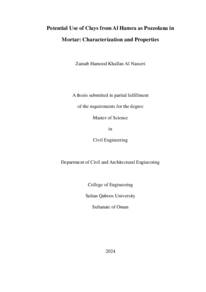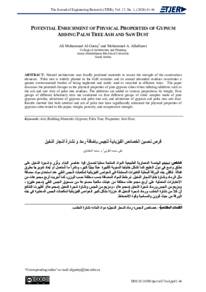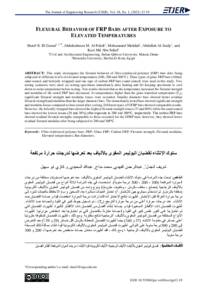Document
Potential use of clays from Al Hamra as Pozzolana in mortar : characterization and properties.
Source
Master's thesis
Other titles
دراسة احتمالیة استخدام طین الحمراء كبوزولانا في الملاط : التوصیف والخصائص
Country
Oman
City
Muscat
Publisher
Sultan Qaboos University
Gregorian
2024
Language
English
Thesis Type
Master's thesis
English abstract
Infrastructure construction is continuously growing due to urbanization and population
growth. This sector produces huge amounts of cement and concrete annually,
contributing to greenhouse gases, energy consumption, and resource depletion. A large
amount of carbon dioxide (CO2) is emitted in ordinary Portland cement (OPC)
production by a calcination process that requires intensive energy consumption at
around 1500 °C. Hence, introducing the sustainability concept in this industry is
crucial in reducing the carbon footprint. Different researchers around the world are
investigating various sustainable materials that can be utilized as partial replacements
for traditional construction materials, which can preserve the environment. One of
these materials is supplementary cementitious materials (SCMs), which increase the
mechanical properties of concrete/mortar, enhance the durability performance, lower
carbon emissions, and are economical.
In this study, two raw clays labeled as HMR-C and HMR-1 were collected from Al
Hamra city in Oman. These materials were utilized as SCMs, and pozzolanic material
in a partial replacement for OPC. A preparation process of screening, grinding, sieving,
and thermal treatment was conducted for both clays. The various physical, chemical,
and microstructural properties of clays were obtained by material characterization. The
X-ray fluorescence (XRF) analysis showed that the combined total of (silica, alumina,
and iron) oxides in calcined HMR-C clay is 91%, and in HMR-1 is 81%. Hence, both
clays were classified as pozzolanic. Additionally, the thermogravimetric analysis
(TGA) and differential scanning calorimetry (DSC) findings revealed that the suitable
calcination temperature of HMR-C is (650 °C and 700 °C), and in HMR-1 is (1000 °C
and 1050 °C). The calcined clay was utilized as a replacement for OPC at different
replacement ratios by weight with a constant w/c ratio of 0.30 in different mortar
mixes. The potential of utilizing the HMR-C and HMR-1 calcined clays as pozzolana
in mortar was examined in two phases. In the first phase, binary mixes were designed
and produced with replacement percentages of (7%, 12%, 20%, and 30%). Depending
in the 28-day compressive strength of this phase, an optimum replacement level of
12% and optimum calcination temperature of 650 °C for HMR-C and 1050 °C for
HMR-1 was selected for the second phase. Different composite mixtures of calcined
clay and various conventional SCMs were designed and produced in this phase. All
the binary and composite mortar samples were experimentally tested to obtain their
various properties. Immediately after mixing, a flowability test, temperature, and fresh
density were performed. Also, the compressive strength and hardened density were
tested at 1, 7, 28, and 91 days. Additionally, the flexural strength of calcined clay
mortar samples was recorded at 28 days. Moreover, the ultrasonic pulse velocity
(UPV), water absorption, and porosity were tested at 91 days. Furthermore, the effect
of submerging mortar samples in a combined solution of (5% sodium sulfate and 5%
sodium chloride) and (5% magnesium sulfate and 5% sodium chloride) for 9 weeks
was tested. Similarly, acid resistance was conducted on mortar samples at 3 months
after 28 days of wet curing; these acids are sulfuric acid, citric acid, nitric acid,
hydrochloric acid, acetic acid, and phosphoric acid. The major outcomes of this study
indicated that as the percentage of HMR-C and HMR-1 clay replacement rises in the
blended paste, the normal consistency also increases, and the setting time is higher
than OPC. It was also observed that the flowability of HMR-C decreases as the
percentage of replacement of Portland cement with calcined clay increases. In contrast,
HMR-1 calcined clay increases the flowability compared with the OPC. In binary
mixes, a reduction in the early strength at 1 day is recorded up to around -45%, and an
enhancement in strength is observed at 7, 28, and 91 days (42.6%, 21.5%, and 8.6%),
respectively, while the composite mixes resulted in lower strength compared with the
plain OPC. An increase in flexural strength is recorded in some samples of HMR-C
and HMR-1 binary and composite mixes. The porosity and water absorption are lower
in HMR-C binary mixes compared to the HMR-1 mixes, and no significant difference
is recorded in UPV. The compressive strength test after exposure to high temperature
(800 °C) showed an increased range of (3.98 to 17.7) % in HMR-C that was calcined
at 700 °C. Moreover, the compressive strength after exposure to (5%Na2SO4
+5%NaCl) and wet/dry cycles resulted in an increase in strength in both clays. A loss
in strength is recorded in all mixes of both clays after exposure to (5%MgSO4
+5%NaCl) and wet/dry cycles. Weight loss, degradation, and color change are
observed after submerging all the HMR-C and HMR-1 mortar samples in various acids
for 9 weeks. Strength increase is detected in most of the HMR-1 samples after
exposure to H3PO4 and C2H4O2 compared with the plain OPC. An increase is also
observed after the HCl, HNO3, and H2SO4 acid attack for both clays.
Arabic abstract
یشھد قطاع تشیید البنیة التحتیة نموا مستمراً بسبب التوسع الحضري ونمو السكان، وينتجهذا القطاع كميات هائلة من الأسمنت والخرصانة سنوياً مما یساھم في انبعاث الغازات المسببة للاحتباس الحراري واستھلاك الطاقة من الأسمنت والخرسانة سنوی واستنزاف الموارد. كما ینبعث قدر كبیر من ثاني أكسید الكربون ( 2CO (في إنتاج الأسمنت البورتلاندي العادي (OPC) من خلال عملية التكلیس التي تتطلب ً استھلاكا مكثفاً للطاقة عند 1500 درجة مئوية. وبالتالي فإن ادخال مفھوم الاستدامة في ھذه الصناعة أمر بالغ الأھمیة للحد من البصمة الكربونیة. یقوم باحثون مختلفون من جمیع أنحاء العالم بالتقصي عن العدید من المواد المستدامة التي یمكن استخدامھا كبدائل جزئیة لمواد البناء التقلیدیة التي یمكن أن تحافظ على البیئة. ومن بین ھذه المواد ھي المواد الأسمنتیة التكمیلیة (SCMs(، التي تزید من الخصائص المیكانیكیة للخرسانة/الملاط، وتعزز أداء المتانة، وتخفض انبعاثات الكربون، بالإضافة إلى أنھا اقتصادیة. في ھذه الدراسة تم جمع نوعین من الطین الخام وھما: C-HMR و -1HMR من مدینة الحمراء في عمان. یتم استخدام ھذه المواد كمواد SCM، وھي مادة بوزولانیة كبدیل لـ OPC. یتم إجراء عملیة تحضیر من الفرز والطحن والغربلة والمعالجة الحراریة في كلا الطینین. یتم الحصول على الخصائص الفیزیائیة والكیمیائیة والبنیة الدقیقة المختلفة للطین من خلال توصیف المواد. أظھر تحلیل الأشعة السینیة الفلوریة (XRF (أن مجموع أكاسید (السیلیكا والألومینا والحدید) في طین C-HMR المحروق ھو ،٪91.09 وفي -1HMR ھو .٪81.027 وبالتالي، یتم تصنیف كلا الطینین على أنھما بوزولانیان. بالإضافة إلى ذلك، أشارت نتائج التحلیل الوزني الحراري (TGA (وقیاس السعرات التفاضلیة بالمسح (DSC (إلى أن درجة حرارة التكلیس المناسبة لـ -HMR C ھي (650 درجة مئویة و 700 درجة مئویة)، وفي -1HMR ھي (1000 درجة مئویة و 1050 درجة مئویة). تم استخدام الطین المحروق كبدیل لـ OPC بنسب استبدال مختلفة بالوزن مع نسبة ثابتة من الماء إلى الأسمنت تساوي 0.3 في خلطات الملاط المختلفة. تم فحص إمكانیة استخدام الطین المحروق C-HMR و -1HMR كبوزولانا في الملاط على مرحلتین. في المرحلة الأولى، تم تصمیم وإنتاج خلطات ثنائیة بنسب استبدال (٪7 و ٪12 و ٪20 و ٪30). ً بناء على الخصائص المیكانیكیة عند 28 ً یوما من ھذه المرحلة، تم اختیار الاستبدال الأمثل بنسبة ٪12 ودرجة حرارة التكلیس المثلى 650 درجة مئویة لـ C-HMR و 1050 درجة مئویة لـ -1HMR للمرحلة الثانیة. تم تصمیم وإنتاج خلطات مركبة مختلفة من الطین المحروق و SCMs المختلفة في ھذه المرحلة . تجریبیا للحصول على خصائصھا المختلفة. یتم إجراء اختبار ً تم اختبار جمیع عینات الملاط الثنائي والمركب السیولة ودرجة الحرارة والكثافة الطازجة مباشرة بعد الخلط. كما تم اختبار قوة الضغط والكثافة المتصلبة عند 1 و 7 و 28 و 91 یوم. بالإضافة إلى ذلك، تم تسجیل قوة الانحناء لعینات ملاط الطین المحروق عند 28 یوم. كما تم إجراء اختبار المسامیة وامتصاص الماء وسرعة النبضة فوق الصوتیة (UPV (عند 91 یوم. كما تم تقییم تأثیر غمر عینات الملاط في محلول مركب من (%5 كبریتات الصودیوم و %5 كلورید الصودیوم) و (%5 كبریتات المغنیسیوم و %5 كلورید الصودیوم) لمدة 9 أسابیع وبالمثل تم إجراء مقاومة الأحماض لعینات الملاط بعد 3 ix أشھر من 28 ً یوما من المعالجة الرطبة وھذه الأحماض ھي حمض الھیدروكلوریك وحمض النیتریك وحمض الفوسفوریك وحمض الكبریتیك وحمض الخلیك وحمض الستریك. أظھرت النتائج الرئیسیة لھذه الدراسة أنھ مع ارتفاع نسبة استبدال طین C-HMR و -1HMR في العجینة الممزوجة، یزداد الاتساق الطبیعي ً أیضا، ویكون وقت التصلب أعلى من OPC. كما لوحظ أن سیولة C-HMR تقل مع زیادة نسبة استبدال الأسمنت البورتلاندي بالطین المحروق. في المقابل، یزید الطین المحروق -1HMR من سیولة مقارنة بـ OPC. في الخلطات الثنائیة، تم تسجیل انخفاض في القوة المبكرة عند یوم واحد یصل إلى - ،٪45.4 ولوحظ تحسن في القوة عند 7 و 28 و 91 ً یوما (٪42.61 و ٪21.53 و ٪8.62) على التوالي، بینما أسفرت الخلطات المركبة عن قوة أقل مقارنة بـ OPC. تم تسجیل زیادة في قوة الانحناء في بعض عینات الخلطات الثنائیة والمركبة C-HMR و -1HMR. أظھرت نتائج اختبار مقاومة الضغط بعد مقاومة الحریق زیادة في نطاق (3.98 إلى 17.73)٪ في 700 / C-HMR درجة مئویة. علاوة على ذلك، أدت مقاومة الضغط بعد التعرض لـ (NaCl+5% 4SO2Na5% (إلى تحسن في القوة في كلا الطینین. تم تسجیل فقدان في القوة في جمیع مخالیط كلا الطینین بعد التعرض لـ (NaCl+5% 4MgSO5%(. لوحظ فقدان الوزن والتحلل وتغیر اللون بعد غمر جمیع عینات ملاط C-HMR و -1HMR في أحماض مختلفة لمدة 9 أسابیع. تم الكشف عن تعزیز القوة في معظم عینات -1HMR بعد التعرض لـ 4PO3H و 2O4H2C مقارنة بـ OPC. لوحظ ً أیضا تحسن بعد ھجوم HCl و 3HNO و 4SO2H في كلا الطینین.
Category
Theses and Dissertations



